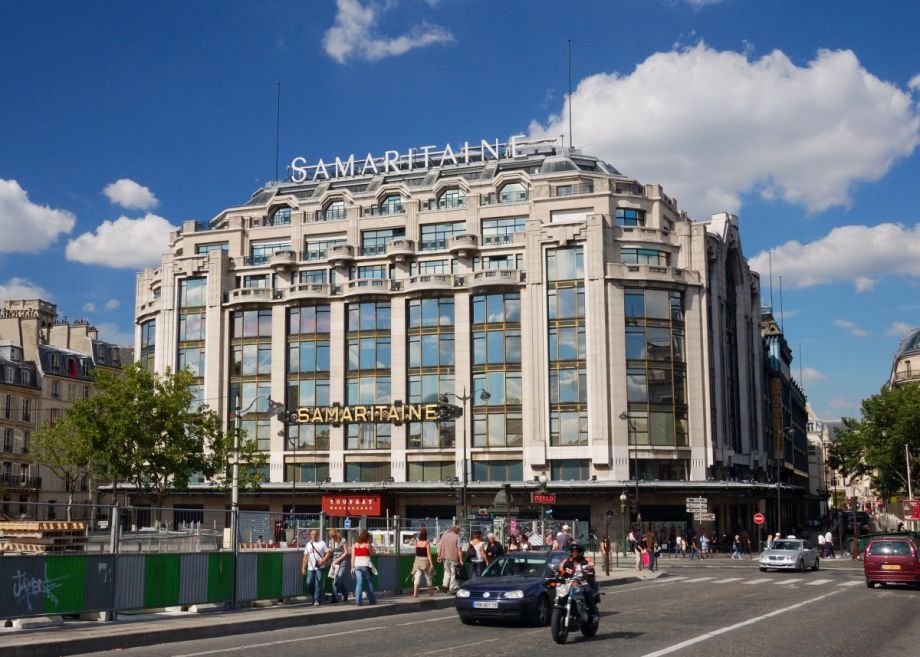There is perhaps no city in the world where the tension between historic preservation and the drive to modernize plays out more vibrantly than Paris. That tension was throw into sharp relief last month, when the French capital was rocked by a court ruling protecting the last façade of landmark department store La Samaritaine, by now already demolished, situated on the Seine across from Pont Neuf. Easily Paris’ most famous department store, La Samaritaine was founded by businessman Ernest Cognacq in 1869 and came to epitomize the fast-growing world of French consumerism and wealth in the 20th century. Its 1933 remodeling by architect Henri Sauvage gave the building a beloved Art Deco form punctuated by a series of setback floors.
The famous store closed in 2005 after years of decline, and luxury-goods juggernaut LVMH, which has owned the building since 2001, wanted to reconstruct La Samaritaine and reopen it as a hotel, apartment and office block. This would involve removing the historic facade of the block facing Rue Rivoli and replacing it with a totally new design from SANAA, a Tokyo-based modern architectural firm. Critics of the glass-walled reconstruction proposal complained that it looked like a shower curtain, and would be a fatal blow to the integrity of the overall complex.
The uproar from both sides of the La Samaritaine fracas says a lot about the current state of urban preservation. We’re living in a time when cities are trying to out-upzone each other at every turn. From New York to London, there’s a growing chorus of build-or-perish ideologues who see preservation as a dangerous impediment to growth. But preservation doesn’t shut down dynamic urban change. On the contrary, preservation is often its guarantor, preventing heavy-handed architectural interventions that would lock a city’s evolution in place. One only need look at the 20th century’s myopic urban renewal projects – most of them still standing – to see how unrestrained development can freeze a city in regrettable amber. In both France and America, the job of the preservationist isn’t to stand in the way of change, it’s to assert the cultural value of legal standards that exist to balance real estate development and the public good.
The La Samaritaine ruling is a perfect example of this. To some observers, the court’s revoking of the reconstruction permit — although moot in protecting the protected facade — is yet another roadblock to Paris’ journey into the 21st century. Parisian developers and politicians fear that the city has slipped from its top-tier stature, and that cultivating contemporary architecture would propel it back into the league of world-class cities. On the other side you have those who see any modern architecture within the city’s core as the first step on a slippery slope to Shanghai-ization.
In truth, preserving what’s left of the original La Samaritaine shows how preservation can create a middle ground. While SOS Paris and the Society for France’s Landscapes and Aesthetics lobbied mostly for enforcement of legal protections of the old department store’s remaining major façade, their pursuit had cultural and economic ramifications as well. Retention of historic buildings with time-tested utility and aesthetic value offer long-term benefits to Paris, even as the city reinvents itself in other ways – with its Grand Paris initiative, for example, which has led to a 26.5-billion-euro rapid transit expansion program slated to be completed by 2030.
American preservationists, too, have become so accustomed to pushing for the enforcement of preservation laws that they often are stereotyped as gatekeepers of nostalgia. Those who fought New York Mayor Michael Bloomberg’s plan for upzoning part of Midtown Manhattan were demonized as anti-development. In truth, they were trying to protect the existing development. Polyphonic streetscapes of buildings of varying heights, styles and forms blended with smart new design attract people. Modern monoliths, embodied by St. Louis’ old Pruitt-Igoe (at worst) or Paris’ La Defense (at best), repel rather than attract people.
When preservationists work to prevent disruptive development, they can succeed even when they fail. In the last year, Cleveland activists led by Jeon Francis of Neighbors in Action had battled to spare the long-vacant, city-owned Fifth Church of Christ, Scientist (1926) from demolition. Architect Jonathan Sandvick worked with developers Chick Holtkamp and Niki Zmij to formulate a $10 million rehabilitation plan that would have transformed the Christian Science church into a rock climbing gym and yoga center.
While the rehabilitation plan sounded good, it was less financially feasible than the proposal by Brickhaus Partners to replace the church entirely with 11 townhouses and a grocery store. In Cleveland, a city dealing with a staggering number of vacant buildings, the plan for new construction was welcomed even by those sympathetic to the preservationist campaign. Cleveland Landmarks Commission member Allan Dreyer told the Cleveland Plain Dealer that the commission rarely saw plans for replacing historic buildings as detailed as what Brickhaus presented.
In May, the Cleveland Landmarks Commission approved demolition with little opposition remaining, and this month the City Council approved the redevelopment plan. Yet preservationists’ interest in the church building led Brickhaus to propose reusing the church’s distinct arched entrance and some of its sandstone ornament as elements in the new project. The developer will also allow a landmark plaque and historical information to be posted on the site. Preservationists seem very pleased at the outcome, as well they should – their efforts forged a third, and better way.
Preservationists are mediators between cultural heritage and economic demands, and they often don’t win what they want. The rambling mass of buildings joined under La Samaritaine’s walls and the stately mass of Cleveland’s Fifth Church of Christ, Scientist are far from evident in the remaining fragments. Yet what has actually been saved in both cases is invisible: the integrity of preservation laws, the enhanced value of developments that incorporate elements of the past and the continuity of urban character that makes cities continue to be desirable places. Years later, no one will see the battle scars from these fights, but they will see interesting works of contemporary architecture based on historic elements, thanks to preservation activists fighting overbearing design.
Correction: This article originally stated that the recent court ruling will protect the facade of La Samaritaine. Though the court ruled in favor of preservation, it did not stay the demolition, and the facade was torn down before that happened. The article has been updated to reflect this.

Michael R. Allen is the founder and director of the Preservation Research Office and a lecturer in American Culture Studies at Washington University in St. Louis. His writing on historic preservation, architectural history and public art has appeared in the St. Louis Post-Dispatch, Temporary Art Review, PreservationNation, nextSTL and other outlets.

















